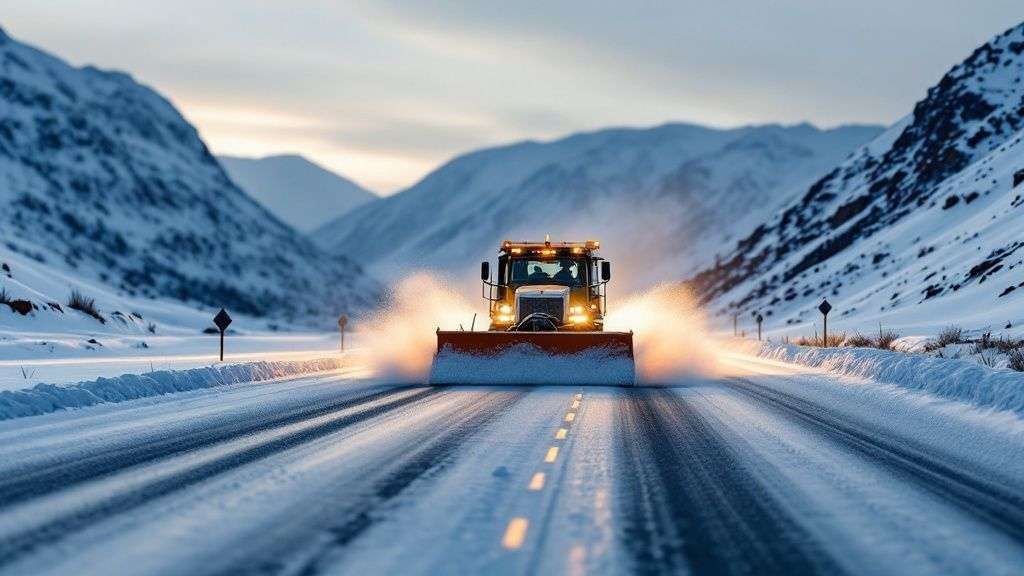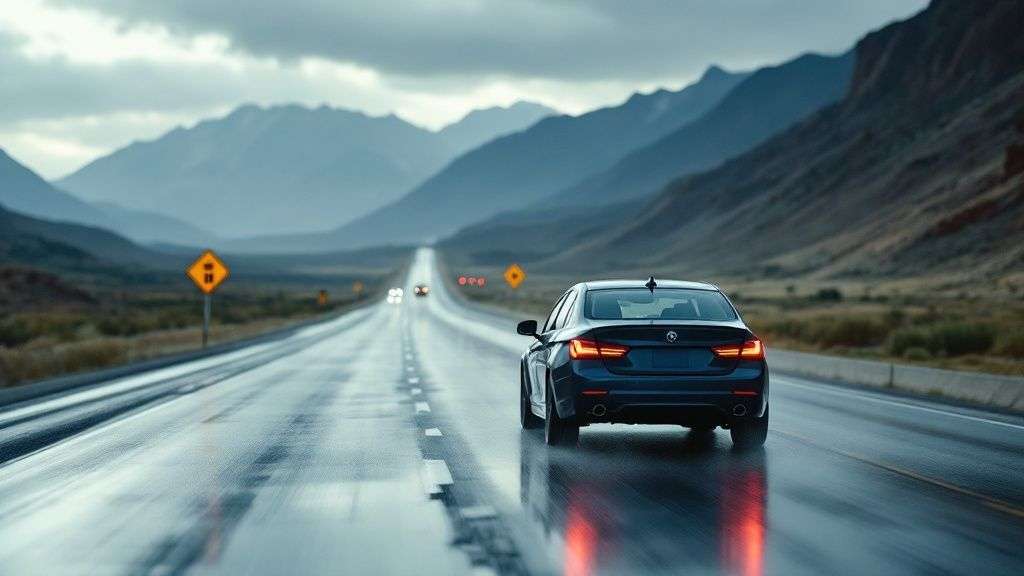How to Check UDOT Road Conditions in Utah's Canyons
Your guide to checking UDOT road conditions in Utah. Learn how to use the UDOT Traffic app, understand traction laws, and get actionable tips for a safe canyon drive.
Checking the latest UDOT road conditions before heading into Utah's canyons is essential for a safe and smooth trip. The most reliable way to get live updates is by using the official UDOT Traffic website and its mobile app. These tools provide real-time camera feeds, traffic alerts, and traction law status, helping you avoid dangerous conditions and long delays in Little Cottonwood Canyon and Big Cottonwood Canyon.
What is the Best Way to Check Road Conditions?
When you need the real story on UDOT road conditions for Utah, there's one simple rule: go straight to the source. The official UDOT Traffic website and its companion mobile app are your best friends for navigating the canyons, providing live, raw data you won't find on generic navigation apps.

The Official UDOT Traffic App
The UDOT Traffic app is a non-negotiable tool for anyone heading into the mountains. It pulls all the critical information together in one place, giving you a clear, honest picture of what you’re about to drive into.
Here's the kind of real-time intel you get that can make or break your trip:
- Live Camera Feeds: See the road with your own eyes. Check out this collection of live cameras for Little Cottonwood Canyon to know exactly what you're up against.
- Traffic Alerts: Get instant pings for accidents, avalanche control, or other slowdowns.
- Snowplow Locations: See precisely where UDOT’s plows are clearing the roads in real-time.
- Traction Law Status: Know immediately if you need 4WD or chains to legally enter the canyon.
Local Tip: By using the official UDOT tools, you get data straight from the agency managing the roads. This eliminates the guesswork and potential delays often found in third-party navigation apps, which may not update as quickly with canyon-specific closures.
Why UDOT's Tools are Better than Google Maps for Canyons
While apps like Google Maps are convenient for everyday driving, they often fall short when it comes to the highly specific, safety-critical information needed for the canyons. This table breaks down why the official UDOT tools are superior for mountain travel.
| Feature | UDOT Traffic App/Website | Google Maps/Waze |
|---|---|---|
| Traction Law Status | Yes, provides real-time, official status. | No, does not show traction law requirements. |
| Avalanche Closures | Yes, posts immediate, accurate closure and reopening info. | Sometimes, but often delayed and may not show partial or rolling closures. |
| Live Road Cameras | Yes, direct access to dozens of live cameras. | No, does not offer live camera feeds. |
| Plow Locations | Yes, shows the current location of snowplows. | No, does not track snowplow activity. |
When Should You Check Road Conditions?
In Utah's mountains, timing is everything. A clear road can become a parking lot in under an hour, so checking udot road conditions utah only after you're already in traffic is too late. The key is to be proactive and check conditions at key intervals before and during your trip.

A Simple Three-Step Timeline
For the safest and least stressful trip, follow this simple timeline:
- The Night Before: Check the forecast for overnight snow and see if UDOT has scheduled any closures for morning avalanche control. This gives you a heads-up on predictable disruptions.
- The Morning Of (Before You Leave): This is your most important check. Open the UDOT app to see the live road status. Are traction laws in effect? Was there an unexpected slide or accident overnight?
- Just Before Entering the Canyon: One last glance at the app as you approach the canyon mouth can save you from a last-minute headache, like a fresh accident or a sudden closure that just happened.
Local Tip: Conditions change fastest during active snowstorms, on powder days when everyone is rushing to the resorts, and during scheduled avalanche control hours. Pay extra attention during these high-risk windows. For a deeper dive, learn about understanding Wasatch weather patterns.
How to Understand UDOT's Road Alerts
The UDOT Traffic app provides powerful data, but you need to understand its visual language to make smart decisions. A ‘Road Weather Alert’ is a heads-up for sketchy conditions like snow or ice, while a ‘Road Closure’ means the road is impassable, usually for avalanche control or a major accident.

Decoding the Traction Law
One of the most critical alerts is ‘Traction Law in Effect.’ This is a legal requirement, not a suggestion. When it's active, your vehicle must have specific equipment to enter the canyon.
- 4WD/AWD Vehicles: Must have tires with an M+S (Mud and Snow) rating or, for better performance, the 3-Peak Mountain Snowflake (3PMSF) symbol.
- 2WD Vehicles: Must have 3PMSF tires or use chains. Real snow tires are a far safer and more practical solution.
The 3PMSF symbol on your tire's sidewall certifies it has passed rigorous tests for severe snow conditions. It provides a massive improvement in grip and stopping power over a standard M+S tire, which is exactly what you need on steep, icy canyon roads.
Actionable Driving Tips for Canyon Safety
Knowing the conditions is the first step; driving them safely is the next. These are practical tips dialed in for the unique challenges of Utah's canyons.
- Prepare Your Vehicle: Ensure your tires have at least 5/32" of tread and meet traction law requirements. Pack an emergency kit with blankets, water, snacks, and a phone charger. Never start up the canyon with less than half a tank of gas.
- Increase Following Distance: On steep, icy roads, your car needs far more room to stop. Give yourself a generous buffer to react if the car ahead brakes or loses control.
- Be Part of the Solution: The infamous "Red Snake" traffic jam is often caused by just one or two unprepared cars spinning out. By arriving prepared, you help keep traffic moving for everyone.
For a comprehensive breakdown of canyon driving techniques, read our winter driving guide for Little Cottonwood Canyon.
Frequently Asked Questions (FAQ)
How accurate is the UDOT Traffic App?
It is the most accurate source available. The UDOT Traffic app pulls real-time data directly from UDOT's roadside weather sensors, live cameras, snowplow GPS trackers, and road crews. This makes it far more reliable for canyon-specific events than third-party apps like Google Maps.
Do I really need snow tires if I have AWD?
Yes. When UDOT activates the Traction Law, AWD alone is not enough. Your tires are what grip the road. At a minimum, your tires must have an M+S (mud and snow) rating. For true safety, tires with the 3-Peak Mountain Snowflake (3PMSF) symbol are strongly recommended as they are certified for severe snow conditions.
What if the canyon closes while I’m at a resort?
Don't panic. Resorts and UDOT have a plan for extended closures, often called an "interlodge." Stay informed by monitoring the resort's and UDOT's social media channels (like @UDOTCottonwoods on X/Twitter) for reopening times. This is why having an emergency kit with extra water and snacks in your car is so important.